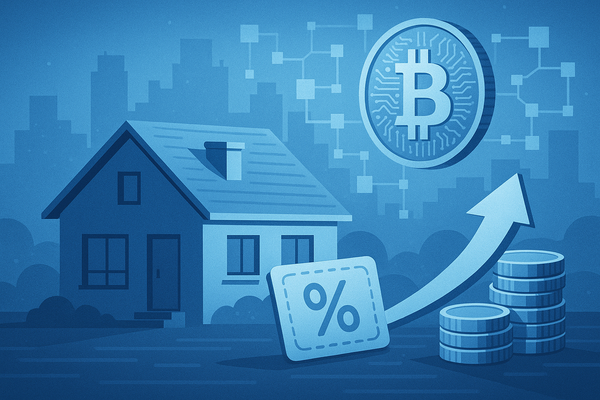The Roaring 2020s: 3 More Years of Euphoria Before the Hangover

In February, I wrote that 2025 would rhyme with 1926, the year when a volatile, skeptical market finally launched into the vertical phase of one of history’s greatest bull runs. By mid-year, that forecast has held: the spring correction shook out the weak hands, and U.S. equities have roared back, setting the stage for a multi-year surge.
Now, another force has emerged that could push this rally beyond anyone’s expectations.
The Trump administration has radically reoriented financial regulation for tokenized assets. Under this framework, meme coins and fully tokenized instruments, stocks, bonds, money-market funds, even real estate are no longer treated as securities. Instead, enforcement shifts from the Securities and Exchange Commission (SEC) to the Commodity Futures Trading Commission (CFTC), a body historically friendlier to innovation and lighter on enforcement.
This single policy shift does more than expand access. It tears down some of the longest-standing guardrails of public markets. Combined with the structural tailwinds already in motion, such as AI adoption, quantum computing, domestic energy expansion, fiscal recalibration, this deregulation could turn the 1920s-style bull into something even more explosive: a parabolic Supercycle.
A New, Deregulated Financial Architecture
This isn’t just about loosening rules on crypto speculation. It’s about redefining how capital markets function.
Paul Atkins, the former SEC Commissioner now leading this deregulatory effort, envisions a world where anyone can buy a fractionalized share of virtually anything, equities, bonds, private companies, cash flows, without a brokerage account and with as little as one dollar. In other words, the final walls between traditional markets and tokenized assets are coming down.
The implications are profound: trillions in previously untapped capital, from retail investors locked out of private equity to global savers unable to access U.S. markets can now flow into tokenized instruments with the same ease as buying Bitcoin. This is financial democratization on a scale unseen since margin accounts and installment buying fueled the speculative frenzy of the 1920s.
Tokenization as the Next Market Catalyst
In a prior analysis, I estimated that if just 25% of U.S. public equities and the largest private companies were tokenized by 2030, it could generate more than $68 trillion in annual trading volume. That’s larger than the U.S. GDP and nearly half the value of all global equities today.
Tokenization has the potential to transform market behavior. Assets once sluggish and illiquid, like private equity or commercial real estate, now trade with the velocity of crypto. Liquidity deepens. Trading becomes nonstop. And in a world where frictionless, fractionalized ownership is available to anyone with a smartphone, capital allocation will happen at speeds our current regulatory frameworks were never designed to handle.
This is what supercharges markets, not just a new pool of capital, but a new structure for capital flows.
The Safeguards Are Gone
There’s a catch.
When you move financial instruments from the SEC’s jurisdiction to the CFTC’s, you don’t just free them from bureaucratic red tape, you strip away protections built to shield investors from abuse and systemic shocks.
Consider what’s missing:
- Circuit breakers: In token markets, there’s no mechanism to halt trading during a crash.
- Disclosure rules: No 5% threshold for reporting large holdings, no 9.9% cap before insider status kicks in.
- Insider trading and manipulation protections: Nearly nonexistent in the token world.
These weren’t arbitrary rules. They were implemented after the Great Depression to protect retail investors and stabilize markets. Removing them invites volatility, manipulation, and unchecked accumulation by the biggest players.
In short: we’ve just rebuilt the markets in the image of crypto—fast, accessible, and unprotected.
Why This Could Drive Markets Parabolic
And yet, for investors willing to navigate this environment, the short-term implication is clear: this deregulation is rocket fuel.
By making every asset tradeable, fractional, and global, we’ve created a market with nearly infinite depth and velocity. Combine that with falling inflation (despite headline fears), looming rate cuts, and a world still starved for growth, and you get the makings of a runaway bull.
If the 1920s blueprint holds, the next three years could deliver 200–300% equity gains. This policy shift suggests that even those estimates may be conservative.
The 1920s Playbook, Updated
The comparison to the Roaring Twenties is a map. Then, like now, America emerged from a pandemic, embraced transformative technologies, and attracted global capital as Europe and Asia faltered. Financial innovation fueled a Supercycle that lifted all boats, until it didn’t.
Today’s innovation is tokenization. And like the installment buying and margin accounts of a century ago, it’s about to change how capital moves and how markets behave.
The Wild West of Capital Markets
This is the most bullish setup for equities in a century, and the most fragile.
By deregulating tokenized assets, Washington has opened the door to a new financial era: faster, more accessible, and more speculative than anything before it. The flood of capital it unleashes could propel indices to unprecedented highs by 2028–29.
But let’s be clear: in stripping away the circuit breakers and disclosure rules that safeguarded markets for nearly a century, we’ve made this bull market a high-speed, high-stakes game.
Party on, for now. But when history rhymes this loudly, we’d do well to remember how the last verse ended.





